Electric Field Lines : Properties and Intensity Due to Point Charge
The concept of Electric Field Lines was introduced by Michael Faraday, he was born on 22nd September 1791 in London and died on 25th August 1867 in Hampton Court Palace, Molesey. In many areas of physics, the electric fields are important and in electrical technology these fields are exploited practically. The attractive force between electrons and the atomic nucleus, the electric fields are responsible. The electric field signal strength SI unit is v/m (volt per meter) and by the time-varying magnetic fields or by the electric charges, the electric fields are created. The brief explanation of electric filed lines and the representation of field lines are discussed.
Mục Lục
What is Electric Field Lines?
Definition: An electric field line is defined as a region in which an electric charge experiences a force. The charged objects can either be positive or negative, the opposite charges attract each other and like charges repel. The field lines are visual representations of the electric field created by a single charge or a group of charges and it is abbreviated as E-field. This is a three-dimensional concept and therefore it cannot be visualized to very great correctness in a plane. The letter E represents the electric field vector and it is tangent to the field line at each point. The direction of these lines is the same as the direction of the electric field vector.
Electric Field Intensity due to Point Charge and Group of Charge
The electric field intensity due to point charges can be obtained by using coulomb’s law. The electric field intensity due to the point charge is shown in the below figure.
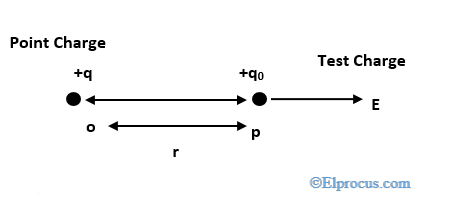
According to coulomb’s law, the force ‘F’ is expressed as
F= q*q0/4Πε0 r2 r ̂ ……………………… eq(1)
The electric field intensity due to a point charge is expressed as.
E=F/q0 r ̂ ……………………. eq (2)
Substitute eq(1) in eq(2) will get electric field intensity expression along with point charge and the test charg
E=q*q0/4Πε0 r2 *1/q0 r ̂
E=q/4Πε0 r2 r ̂……………… eq (3)
Where r ̂ is the unit vector
An equation (3) is the electric field intensity due to point charge along with point charge and the test charge. The electric field intensity due to the group of charges is shown in the below figure
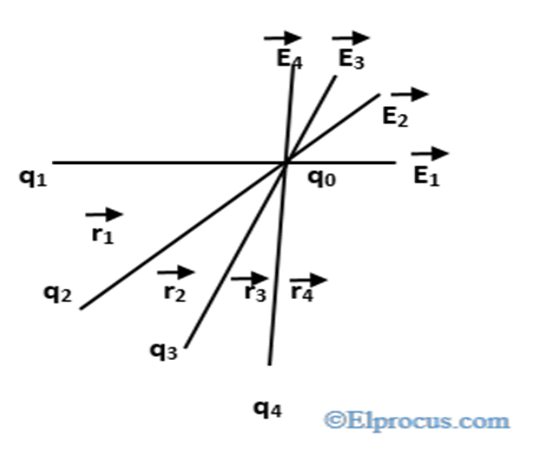
Where q1, q2, q3, q4, q5, q6………. qn are the charges and r1, r2, r3, r4, r5, r6………. rn are the distances.
The electric field intensity due to the group of charges at point p is given by
E=E1+ E2+ E3+ E4+………+ En ……………………. eq (4)
As we know that the electric field intensity due to point charge is expressed in the above eq (3), similarly
E1=q1/4Πε0 r12 r ̂1
E2=q2/4Πε0 r22 r ̂2
E3=q3/4Πε0 r32 r ̂3 …………En=qn/4Πε0 rn2 r ̂n
Substitute E1, E2, E3, E4,………En values in the eq (4) will get
E= q1/4Πε0r12r ̂1+q2/4Πε0r22r ̂2+q3/4Πε0r32r ̂3+………..+qn/4Πε0 rn2 r ̂n
E= 1/4Πε0[q1 /r12r ̂1 +q2/r22 r ̂2+q3/r32 r3 ̂+………..+qn/rn2 r ̂n]…………………………. eq(5)
An equation (5) is the electric field intensity due to the group of charges
Representation of Field Lines
For q>0: When q is greater than zero (q>0), the charge is positive and the field lines are radially outward. The field lines for q>0 are shown in the below figure.
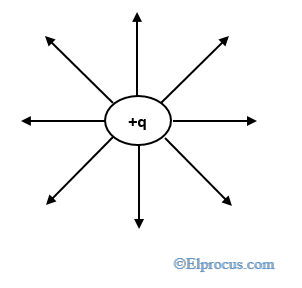
For q<0: When q is less than zero (q<0), the charge is negative and the field lines are radially inward. The field lines for q<0 are shown in the below figure.
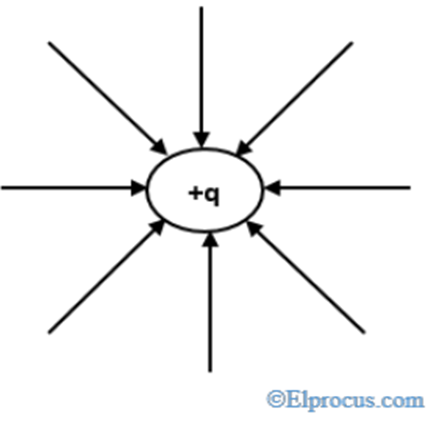
Unlike Charges or Dipole: The representation of field lines for unlike charges or dipole is shown in the below figure.
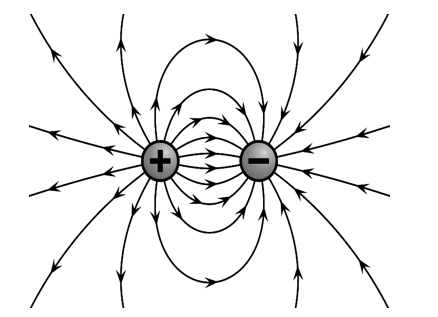
For Similar Charges
If |q1| = |q2|: If charge q1 and q2 are equal, the neutral point and the field intensity is zero for similar charges and it is at the center of q1 and q2 charges.
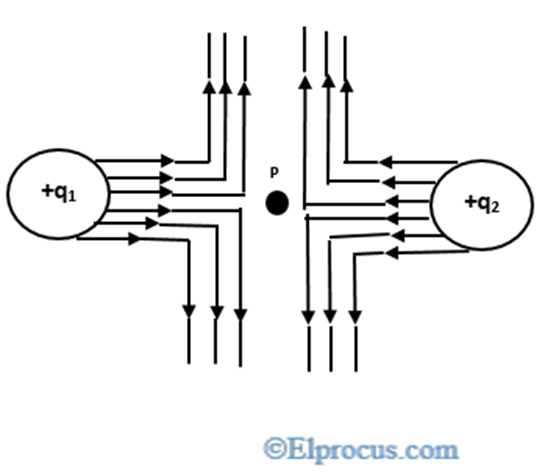
If |q1|>|q2|: If charge q1 is greater than q2, the neutral point ‘p’ shift towards the charge q2 of smaller magnitude.
Uniform Electric Field: In the uniform electric field the field lines start from the positive charge and goes to negative charge. The field lines are equidistant and lines are parallel in the uniform electric field.
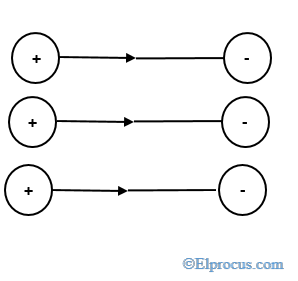
Properties
The properties of electric field lines are
- The field lines start from positive charge and terminate at the negative charge
- The field lines are continuous
- The field lines never intersect (Reason: If they intersect each other, there will be two directions of an electric field at the point which is not possible)
- In the region of the strong electric field, lines are very close to each other whereas in the region of weak electric field lines are far
- In the region of uniform electric field line, there are equidistant parallel lines
- The field lines are always normal to the surface of the conductor
Rules for Drawing Electric Field Lines
The rules for drawing field lines are
- For a given group of point charges, the field lines always originate from positive charge and end in a negative charge. In case there is some excess charge then some lines will begin or end indefinitely.
For example, in the above figure q1 is greater than q2. The lines are originating in q2, so charge q2 is positive and in the charge q1 some lines are coming from infinitely far away. - The number of lines drawn ending on a negative charge or leaving a positive charge is proportional to the magnitude of the charge.
So higher the charge more lines will leave from it if it is a positive charge or end in it if it is a negative charge. - The field lines never cross each other
FAQ’s
1). What are the types of electric field lines?
The uniform electric field and non-uniform electric field are the two types of electric field lines. The field line is said to be a uniform electric field when the electric field is constant and said to be a non-uniform electric field when the field is irregular at every point.
2). How do you make an electric field?
By the stationary charges, the electric field is produced, and by the moving charges the magnetic field is produced.
3). How the electric field is produced?
The electric field is produced by the charged particles. In the direction of the field, positive charges are accelerating and in the opposite direction of the field, the negatively charged particles are accelerated.
4). What is electric field intensity due to point charges?
The electric field intensity due to point charge along with point charge and test charge is expressed as
E=q/4Πε0 r2 r ̂
Where E is the electric field intensity, r ̂ is the unit vector and q is the charge.
5). How do electric field lines indicate the strength of the field?
The electric field lines strength depends on the source charge and the electric field is strong when the field lines are close together.
In this article, electric field intensity due to point charge and group of charge, representation of field lines, properties field lines, and rules for drawing electric field lines are discussed. Here is a question for you, what is a test charge and point charge in an electric field?















![Toni Kroos là ai? [ sự thật về tiểu sử đầy đủ Toni Kroos ]](https://evbn.org/wp-content/uploads/New-Project-6635-1671934592.jpg)


